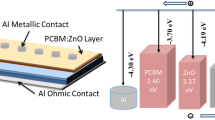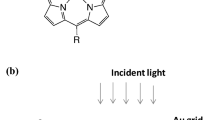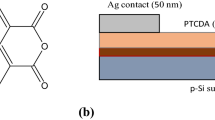Abstract
[6,6]-Phenyl C61-butyric acid methyl ester (PCBM) is a good electron transport material and can be employed in optoelectronic application. To understand the effect of the amount ratio on the capacitive behaviors, the pristine ZnO, 3%, 5% and 10% amounts PCBM (low amount) added ZnO interfacial layered Al/ZnO:PCBM/p-Si heterojunction structures have been fabricated by sol–gel spin-coating method and characterized by X-ray diffraction (XRD), capacitance–voltage (C-V) and conductance-voltage (G-V) measurements for the frequency range between 10 kHz and 1 MHz. Some electrical parameters of the pristine ZnO and various PCBM added ZnO interlayered devices have been calculated from 1/C2-V (1/capacitance2-voltage) plots for various frequencies. Moreover, capacitance transient (C-t) and conductance-transient (G-t) measurements of the Al/ZnO:PCBM/p-Si devices have been performed for various light illumination intensities from 20 to 100 mW/cm2 with 20 mW/cm2 increments under light illumination which has whole spectral matching. The results revealed that PCBM amount has a great effect on capacitance and conductivity values of the Al/ZnO:PCBM/p-Si devices.








Similar content being viewed by others
References
R.H. Al Orainy, A.A. Hendi, Fabrication and electrical characterization of CdO/p-Si photosensors. Microelectron. Eng. 127, 14–20 (2014). https://doi.org/10.1016/j.mee.2014.02.014
A. Kocyigit, M. Yılmaz, Ş Aydoğan, Ü. İncekara, The effect of measurements and layer coating homogeneity of AB on the Al/AB/p-Si devices. J. Alloys Compd. 790, 388–396 (2019). https://doi.org/10.1016/j.jallcom.2019.03.179
R. Balakarthikeyan, A. Santhanam, R. Anandhi, S. Vinoth, A.M. Al-Baradi, Z.A. Alrowaili, M.S. Al-Buriahi, K. Deva Arun Kumar, Fabrication of nanostructured NiO and NiO: Cu thin films for high-performance ultraviolet photodetector. Opt. Mater. Amst. 120, 111387 (2021). https://doi.org/10.1016/j.optmat.2021.111387
X. Zhou, L. Wang, X. Zhang, Y. Qiu, Direct and alternating electrical performance of TiO2/SiO2/p-Si heterojunction under visible illumination. Thin Solid Films 718, 138477 (2021). https://doi.org/10.1016/j.tsf.2020.138477
A. Das Mahapatra, D. Basak, Investigation on sub-band gap defects aided UV to NIR broad-band low-intensity photodetection by SnO2 thin film. Sens. Actuators, A Phys. 312, 112168 (2020). https://doi.org/10.1016/j.sna.2020.112168
F. Yakuphanoglu, Y. Caglar, M. Caglar, S. Ilican, ZnO/p-Si heterojunction photodiode by solgel deposition of nanostructure n-ZnO film on p-Si substrate. Mater. Sci. Semicond. Process. 13, 137–140 (2010). https://doi.org/10.1016/j.mssp.2010.05.005
Ü. Özgür, Y.I. Alivov, C. Liu, A. Teke, M.A. Reshchikov, S. Doǧan, V. Avrutin, S.J. Cho, H. Morko̧, A comprehensive review of ZnO materials and devices. J. Appl. Phys. 98, 1–103 (2005)
Ü. Ozgur, D. Hofstetter, H. Morkoç, ZnO devices and applications: a review of current status and future prospects. Proc. IEEE 98, 1255–1268 (2010). https://doi.org/10.1109/JPROC.2010.2044550
W. Gao, Z. Li, ZnO thin films produced by magnetron sputtering. Ceram. Int. 30, 1155–1159 (2004). https://doi.org/10.1016/j.ceramint.2003.12.197
Y. Chen, D.M. Bagnall, H. Koh, K. Park, K. Hiraga, Z. Zhu, T. Yao, Plasma assisted molecular beam epitaxy of ZnO on c -plane sapphire: Growth and characterization. J. Appl. Phys. 84, 3912–3918 (1998). https://doi.org/10.1063/1.368595
J.N. Zeng, J.K. Low, Z.M. Ren, T. Liew, Y.F. Lu, Effect of deposition conditions on optical and electrical properties of ZnO films prepared by pulsed laser deposition. Appl. Surf. Sci. 197–198, 362–367 (2002). https://doi.org/10.1016/S0169-4332(02)00425-7
S.T. Tan, B.J. Chen, X.W. Sun, W.J. Fan, H.S. Kwok, X.H. Zhang, S.J. Chua, Blueshift of optical band gap in ZnO thin films grown by metal-organic chemical-vapor deposition. J. Appl. Phys. 98, 013505 (2005). https://doi.org/10.1063/1.1940137
R. Ayouchi, F. Martin, D. Leinen, J.R. Ramos-Barrado, Growth of pure ZnO thin films prepared by chemical spray pyrolysis on silicon. J. Cryst. Growth 247, 497–504 (2003). https://doi.org/10.1016/S0022-0248(02)01917-6
S. Ilican, M. Caglar, Preparation and characterization of ZnO thin films deposited. J. Optoelectron. Adv. Mater. 10, 2578–2583 (2008)
J.Y. Lee, Y.S. Choi, J.H. Kim, M.O. Park, S. Im, Optimizing n-ZnO/p-Si heterojunctions for photodiode applications. Thin Solid Films 403–404, 553–557 (2002). https://doi.org/10.1016/S0040-6090(01)01550-4
Ş Karataş, H.M. El-Nasser, A.A. Al-Ghamdi, F. Yakuphanoglu, High photoresponsivity Ru-doped ZnO/p-Si heterojunction diodes by the sol-gel method. SILICON 10, 651–658 (2018). https://doi.org/10.1007/s12633-016-9508-7
S. Baturay, Y.S. Ocak, D. Kaya, The effect of Gd doping on the electrical and photoelectrical properties of Gd:ZnO/p-Si heterojunctions. J. Alloys Compd. 645, 29–33 (2015). https://doi.org/10.1016/j.jallcom.2015.04.212
M. Yıldırım, A. Kocyigit, Characterization of Al/In:ZnO/p-Si photodiodes for various In doped level to ZnO interfacial layers. J. Alloys Compd. 768, 1064–1075 (2018). https://doi.org/10.1016/j.jallcom.2018.07.295
B. Zimmermann, U. Würfel, M. Niggemann, Longterm stability of efficient inverted P3HT:PCBM solar cells. Sol. Energy Mater. Sol. Cells 93, 491–496 (2009). https://doi.org/10.1016/j.solmat.2008.12.022
J.C. Hummelen, B.W. Knight, F. LePeq, F. Wudl, J. Yao, C.L. Wilkins, Preparation and characterization of fulleroid and methanofullerene derivatives. J. Org. Chem. 60, 532–538 (1995). https://doi.org/10.1021/jo00108a012
F. Yakuphanoglu, Photovoltaic properties of hybrid organic/inorganic semiconductor photodiode. Synth. Met. 157, 859–862 (2007). https://doi.org/10.1016/j.synthmet.2007.08.012
H.H. Gullu, D.E. Yildiz, A. Kocyigit, M. Yıldırım, Electrical properties of Al/PCBM:ZnO/p-Si heterojunction for photodiode application. J. Alloys Compd. 827, 154279 (2020). https://doi.org/10.1016/j.jallcom.2020.154279
T. Öztürk, Effect of various PCBM doping on the interfacial layer of Al/PCBM:ZnO/p-Si photodiodes. J. Mater. Sci. Mater. Electron. 32, 10180–10193 (2021). https://doi.org/10.1007/s10854-021-05674-3
S. Demirezen, H.G. Çetinkaya, Altındal doping rate, interface states and polarization effects on dielectric properties, electric modulus, and AC conductivity in PCBM/NiO:ZnO/p-Si structures in wide frequency range. SILICON 1, 1–11 (2022). https://doi.org/10.1007/s12633-021-01640-0
H. Altan, M. Özer, H. Ezgin, Investigation of electrical parameters of Au/P3HT:PCBM/n-6H–SiC/Ag Schottky barrier diode with different current conduction models. Superlattices Microstruct. 146, 106658 (2020). https://doi.org/10.1016/j.spmi.2020.106658
S. Cho, K.D. Kim, J. Heo, J.Y. Lee, G. Cha, B.Y. Seo, Y.D. Kim, Y.S. Kim, S.Y. Choi, D.C. Lim, Role of additional PCBM layer between ZnO and photoactive layers in inverted bulk-heterojunction solar cells. Sci. Rep. 4, 1–6 (2014). https://doi.org/10.1038/srep04306
S. Demirezen, H.G. Çetinkaya, M. Kara, F. Yakuphanoğlu, Ş Altındal, Synthesis, electrical and photo-sensing characteristics of the Al/(PCBM/NiO: ZnO)/p-Si nanocomposite structures. Sens. Actuators, A Phys. 317, 112449 (2021). https://doi.org/10.1016/j.sna.2020.112449
B. Kadem, R.K. Fakher Alfahed, A.S. Al-Asadi, H.A. Badran, Morphological, structural, optical, and photovoltaic cell of copolymer P3HT: ICBA and P3HT:PCBM. Optik (Stuttg). 204, 164153 (2020). https://doi.org/10.1016/j.ijleo.2019.164153
A.T. Mallajosyula, S. Sundar Kumar Iyer, B. Mazhari, Capacitance-voltage characteristics of P3HT:PCBM bulk heterojunction solar cells with ohmic contacts and the impact of single walled carbon nanotubes on them. Org. Electron. 13, 1158–1165 (2012). https://doi.org/10.1016/j.orgel.2012.03.018
A. Sarkar, A. Bin Rahaman, D. Banerjee, Temperature dependent charge transport studies across thermodynamic glass transition in P3HT:PCBM bulk heterojunction: insight from J-V and impedance spectroscopy. J. Phys. D. Appl. Phys. 51, 095602 (2018). https://doi.org/10.1088/1361-6463/aaa87c
S. Arora, V. Singh, M. Arora, R. Pal Tandon, Evaluating effect of surface state density at the interfaces in degraded bulk heterojunction organic solar cell. Physica B 407, 3044–3046 (2012)
H.H. Gullu, D.E. Yildiz, L. Toppare, A. Cirpan, Electrical characteristics of organic heterojunction with an alternating benzotriazole and fluorene containing copolymer. J. Mater. Sci. Mater. Electron. 31, 18816–18831 (2020). https://doi.org/10.1007/s10854-020-04421-4
Ö. Tüzün Özmen, E. Yaǧlioǧlu, Electrical and interfacial properties of Au/P3HT:PCBM/n-Si Schottky barrier diodes at room temperature. Mater. Sci. Semicond. Process. 26, 448–454 (2014). https://doi.org/10.1016/j.mssp.2014.04.013
F. Aslan, H. Esen, F. Yakuphanoglu, Electrical and fotoconducting characterization of Al/coumarin:ZnO/Al novel organic-inorganic hybrid photodiodes. J. Alloys Compd. 789, 595–606 (2019). https://doi.org/10.1016/j.jallcom.2019.03.090
Z. Çaldıran, Modification of Schottky barrier height using an inorganic compound interface layer for various contact metals in the metal/p-Si device structure. J. Alloys Compd. 865, 158856 (2021). https://doi.org/10.1016/j.jallcom.2021.158856
P.Y. Wu, J. Pike, F. Zhang, S.W. Chan, Low-temperature synthesis of zinc oxide nanoparticles. Int. J. Appl. Ceram. Technol. 3, 272–278 (2006). https://doi.org/10.1111/j.1744-7402.2006.02091.x
S. Bai, J. Hu, D. Li, R. Luo, A. Chen, C.C. Liu, Quantum-sized ZnO nanoparticles: synthesis, characterization and sensing properties for NO2. J. Mater. Chem. 21, 12288–12294 (2011). https://doi.org/10.1039/c1jm11302j
A. Rodrigues, M.C.R. Castro, A.S.F. Farinha, M. Oliveira, J.P.C. Tomé, A.V. Machado, M.M.M. Raposo, L. Hilliou, G. Bernardo, Thermal stability of P3HT and P3HT:PCBM blends in the molten state. Polym. Test. 32, 1192–1201 (2013). https://doi.org/10.1016/j.polymertesting.2013.07.008
M. Bououdina, S. Azzaza, R. Ghomri, M.N. Shaikh, J.H. Dai, Y. Song, W. Song, W. Cai, M. Ghers, Structural and magnetic properties and DFT analysis of ZnO:(Al, Er) nanoparticles. RSC Adv. 7, 32931–32941 (2017). https://doi.org/10.1039/c7ra01015j
C. Wang, H. Hao, D. Hashizume, K. Tajima, Surface-induced enantiomorphic crystallization of achiral fullerene derivatives in thin films. Chem. Sci. 11, 4702–4708 (2020). https://doi.org/10.1039/d0sc01163k
Ö. Sevgili, Y. Azizian-Kalandaragh, Ş Altındal, Frequency and voltage dependence of electrical and dielectric properties in metal-interfacial layer-semiconductor (MIS) type structures. Phys. B Condens. Matter 587, 412122 (2020). https://doi.org/10.1016/j.physb.2020.412122
M. Ulusoy, S. Altındal, Y. Azizian-Kalandaragh, S. Özçelik, Z. Mirzaei-Kalar, The electrical characteristic of an MIS structure with biocompatible minerals doped (Brushite+Monetite: PVC) interface layer. Microelectron. Eng. 258, 111768 (2022). https://doi.org/10.1016/j.mee.2022.111768
M.O. Erdal, M. Yıldırım, A. Kocyigit, A comparison of the electrical characteristics of TiO2/p-Si/Ag, GNR-TiO2/p-Si/Ag and MWCNT-TiO2/p-Si/Ag photodiodes. J. Mater. Sci. Mater. Electron. 30, 13617–13626 (2019). https://doi.org/10.1007/s10854-019-01731-0
M.O. Erdal, A. Kocyigit, M. Yıldırım, The C-V characteristics of TiO2/p-Si/Ag, GNR doped TiO2/p-Si/Ag and MWCNT doped TiO2/p-Si/Ag heterojunction devices. Chinese J. Phys. 64, 163–173 (2020). https://doi.org/10.1016/j.cjph.2019.12.021
Ç.G. Türk, S.O. Tan, Ş Altındal, B. İnem, Frequency and voltage dependence of barrier height, surface states, and series resistance in Al/Al2O3/p-Si structures in wide range frequency and voltage. Phys. B Condens. Matter 582, 411979 (2020). https://doi.org/10.1016/j.physb.2019.411979
S. Kaya, A. Aktag, E. Yilmaz, Effects of gamma-ray irradiation on interface states and series-resistance characteristics of BiFeO3 MOS capacitors. Nucl. Instrum. Methods Phys Res. Sect. B Beam Interact. Mater. Atoms 319, 44–47 (2014). https://doi.org/10.1016/j.nimb.2013.11.006
M. Gökçen, H. Altuntaş, Ş Altındal, S. Özçelik, Frequency and voltage dependence of negative capacitance in Au/SiO2/n-GaAs structures. Mater. Sci. Semicond. Process. 15, 41–46 (2012). https://doi.org/10.1016/j.mssp.2011.08.001
B.K. Jones, J. Santana, M. McPherson, Negative capacitance effects in semiconductor diodes. Solid State Commun. 107, 47–50 (1998). https://doi.org/10.1016/S0038-1098(98)00162-8
A. Gadisa, K. Tvingstedt, K. Vandewal, F. Zhang, J.V. Manca, O. Inganäs, Bipolar charge transport in fullerene molecules in a bilayer and blend of polyfluorene copolymer and fullerene. Adv. Mater. 22, 1008–1011 (2010). https://doi.org/10.1002/adma.200902579
D. Bartesaghi, M. Turbiez, L.J.A. Koster, Charge transport and recombination in PDPP5T:[70]PCBM organic solar cells: the influence of morphology. Org. Electron. 15, 3191–3202 (2014). https://doi.org/10.1016/j.orgel.2014.08.064
D. Yang, X. Zhang, K. Wang, C. Wu, R. Yang, Y. Hou, Y. Jiang, S. Liu, S. Priya, Stable efficiency exceeding 20.6% for inverted perovskite solar cells through polymer-optimized PCBM electron-transport layers. Nano Lett. 19, 3313–3320 (2019). https://doi.org/10.1021/acs.nanolett.9b00936
A. Turut, A. Karabulut, K. Ejderha, N. Bıyıklı, Capacitance–conductance–current–voltage characteristics of atomic layer deposited Au/Ti/Al2O3/n-GaAs MIS structures. Mater. Sci. Semicond. Process. 39, 400–407 (2015). https://doi.org/10.1016/j.mssp.2015.05.025
B.A. Prew, Physics of semiconductor devices. Phys. Bull. 26, 399–403 (1975). https://doi.org/10.1088/0031-9112/26/9/031
S. Demirezen, Ş Altlndal, Y. Azizian-Kalandaragh, A.M. Akbaş, A comparison of Au/n-Si Schottky diodes (SDs) with/without a nanographite (NG) interfacial layer by considering interlayer, surface states (Nss) and series resistance (Rs) effects. Phys. Scr. 97, 055811 (2022). https://doi.org/10.1088/1402-4896/ac645f
H.G. Çetinkaya, S. Demirezen, S. Altındal Yerişkin, Electrical parameters of Au/(%1Ni-PVA)/n-Si (MPS) structure: surface states and their lifetimes. Phys. B Condens. Matter 621, 413207 (2021). https://doi.org/10.1016/j.physb.2021.413207
S. Altındal Yerişkin, Y. Şafak Asar, Influence of graphene doping rate in PVA organic thin film on the performance of Al/p-Si structure. J. Mater. Sci. Mater. Electron. 32, 22860–22867 (2021). https://doi.org/10.1007/s10854-021-06763-z
M. Yıldırım, M.O. Erdal, A. Kocyigit, The effect of indium doping concentration on the electrical and dielectric properties of Al/In:ZnO/p-Si heterojunctions. Phys. B Condens. Matter 572, 153–160 (2019). https://doi.org/10.1016/j.physb.2019.07.055
A.A.M. Farag, B. Gunduz, F. Yakuphanoglu, W.A. Farooq, Controlling of electrical characteristics of Al/p-Si Schottky diode by tris(8-hydroxyquinolinato) aluminum organic film. Synth. Met. 160, 2559–2563 (2010). https://doi.org/10.1016/j.synthmet.2010.10.005
M. Yildirim, A. Kocyigit, A systematic study on the dielectric relaxation, electric modulus and electrical conductivity of Al/Cu:TiO2n -Si (MOS) structures/capacitors. Surf. Rev. Lett. 27, 1950217 (2020). https://doi.org/10.1142/S0218625X19502172
W.A. Hill, C.C. Coleman, A single-frequency approximation for interface-state density determination. Solid. State. Electron. 23, 987–993 (1980). https://doi.org/10.1016/0038-1101(80)90064-7
E.H. Nicollian, J.R. Brews, MOS (metal oxide semiconductor) physics and technology (John Wiley & Sons, Somerset, 2003)
Ç. Bilkan, Ş Altındal, Y. Azizian-Kalandaragh, Investigation of frequency and voltage dependence surface states and series resistance profiles using admittance measurements in Al/p-Si with Co3O4-PVA interlayer structures. Phys. B Condens. Matter 515, 28–33 (2017). https://doi.org/10.1016/J.PHYSB.2017.04.002
S. Zeyrek, E. Acaroğlu, Ş Altındal, S. Birdoğan, M.M. Bülbül, The effect of series resistance and interface states on the frequency dependent C-V and G/w–V characteristics of Al/perylene/p-Si MPS type Schottky barrier diodes. Curr. Appl. Phys. 13, 1225–1230 (2013). https://doi.org/10.1016/j.cap.2013.03.014
M. Yıldırım, Characterization of the framework of Cu doped TiO2 layers: An insight into optical, electrical and photodiode parameters. J. Alloys Compd. 773, 890–904 (2019). https://doi.org/10.1016/J.JALLCOM.2018.09.276
A. Kocyigit, M. Yıldırım, A. Sarılmaz, F. Ozel, The Au/Cu2WSe4/p-Si photodiode: electrical and morphological characterization. J. Alloys Compd. 780, 186–192 (2019). https://doi.org/10.1016/j.jallcom.2018.11.372
M.O. Erdal, A. Kocyigit, M. Yıldırım, The rate of Cu doped TiO2 interlayer effects on the electrical characteristics of Al/Cu:TiO2/n-Si (MOS) capacitors depend on frequency and voltage. Microelectron. Reliab. 106, 113591 (2020). https://doi.org/10.1016/j.microrel.2020.113591
U.K. Verma, S. Kumar, Y.N. Mohapatra, Measurement of contact surface photo-voltage from forward bias C-V characteristics of P3HT:PCBM based BHJ solar cells. Sol. Energy Mater. Sol. Cells 172, 25–33 (2017). https://doi.org/10.1016/j.solmat.2017.07.010
Funding
This work was supported by Selcuk University BAP office with Project Number 19401034.
Author information
Authors and Affiliations
Contributions
Conceptualization, M.Y.; methodology, M.Y. and A.K.; investigation, M.Y. and A.K.; writing—original draft preparation, M.Y. and A.K.; writing—review, supervision and editing, M.Y. and A.K. All authors have read and agreed to the published version of the manuscript.
Corresponding author
Ethics declarations
Conflict of interest
The authors declare no conflict of interest.
Additional information
Publisher's Note
Springer Nature remains neutral with regard to jurisdictional claims in published maps and institutional affiliations.
Rights and permissions
About this article
Cite this article
Yıldırım, M., Kocyigit, A. Investigation photoelectric characteristics of ZnO/p-Si heterojunction structure modification with PCBM. Appl. Phys. A 128, 700 (2022). https://doi.org/10.1007/s00339-022-05842-0
Received:
Accepted:
Published:
DOI: https://doi.org/10.1007/s00339-022-05842-0




